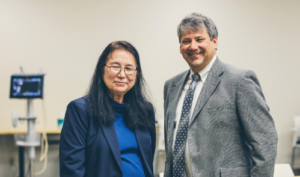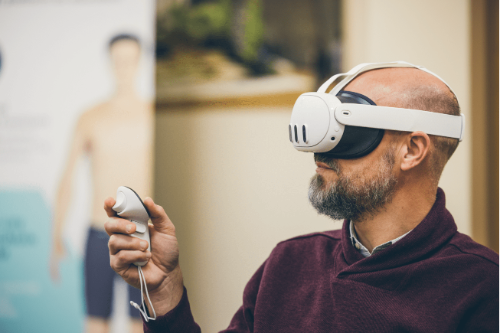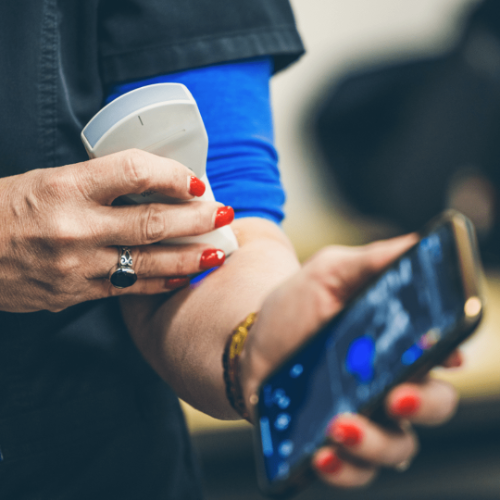Alice L. Walton School of Medicine Holds Inaugural Simulation Vendor Fair
February 22, 2024
On February 20, 2024, Alice L. Walton School of Medicine hosted leading medical technology and simulation system companies at its inaugural Simulation Vendor Fair, where members of the School’s faculty, staff, and leadership teams, alongside guest clinicians from the community, had the opportunity to evaluate and interact with technologies the School may use.
The event was spearheaded by AWSOM leaders Sylvia Merino, Director of Simulation, and Dr. Kevin Kunkler, Assistant Dean of Simulation, Innovation, and Clinical Skills.

“We felt strongly about holding the Fair because it allows faculty and staff to experience simulation technology that can bring courses alive with hands-on, immersive activities.” said Merino.
Technologies represented at the Fair included:
- Extended reality (XR) with 3D modeling
- Ultrasonography
- Auscultation devices
- Obstetrics and gynecology (OB-GYN) trainers
Immersive Extended Reality

Faculty and staff evaluated virtual and augmented reality headset to enhance the School’s proposed anatomy program. These tools, which both fall under the umbrella of XR technology, allow groups to simultaneously view and interact with high-definition anatomical models and medical images (such as CT scans) in three dimensions. Users can rotate, enlarge, and highlight parts of these models with ease.
“XR technology is a game-changer for medical education. It enables educators to provide students with immersive and engaging learning experiences that are not always possible in a traditional classroom or lab,” said Jason Degn, Director of Information Technology. “By using XR, we can enhance students’ learning of complex anatomical structures and concepts and deliver the experience from any location with Wi-Fi.”
Hands-On Ultrasound Technology
Both real and simulated point-of-care ultrasound (POCUS) devices were demonstrated at the Fair. Ultrasound technology is an integral tool in modern clinical care settings. The images produced by these small and portable medical devices are dynamic, easily reproducible, and can guide medical professionals in making quick, accurate decisions. However, the quality of the ultrasound image varies depending on the skill of the caregiver using the equipment.
In recent years, forward-thinking institutions have established POCUS training programs to ensure students are comfortable and skilled at using this technology before graduation.

A Focus on OB-GYN Care
A birthing manikin, also known as a birth simulator or maternity manikin, is a realistic training tool used to replicate childbirth scenarios. This technology allows learners to practice providing care before, during, and after delivery.
The School hopes to support the efforts to improve maternal care by emphasizing OB-GYN skills in its proposed curriculum. Birthing manikins and other training technology allow students to build confidence and refine their clinical expertise, with the goal of improving quality of care for obstetric patients.
Founding Dean and Chief Executive Officer Dr. Sharmila Makhija is an international expert on gynecological cancer and an advocate for maternal health. She currently serves on the board of Every Mother Counts, a nonprofit focused on improving maternal health care worldwide.
Developing an Ear for Medicine
Auscultation is the method of listening to the internal sounds of the body, such as the heartbeat and breathing, typically by using a stethoscope. Auscultation trainers are devices that teach proper stethoscope placement and familiarize learners with normal and abnormal sounds. It takes a trained ear to these respect sounds and formulate a diagnosis.
“When used strategically, simulation technology can engage multiple senses. We want to incorporate technologies that allow us to simulate seeing, touching, and hearing what you would encounter in a real clinical environment, creating the richest experience possible.” Merino said.
One auscultation tool featured at the Fair was a stethoscope attachment that can be used with standardized patients, or individuals trained to work with medical students under faculty supervision. The attachment can be programmed to mimic the body sounds associated with certain health conditions, such as an abnormally quick heartbeat.

Evaluators also used traditional stethoscopes on manikins that produced realistic breathing and pulse sounds in the same locations they would be detected in the human body.
Building a Cutting-Edge Learning Environment
Following the success of the inaugural Simulation Vendor Fair, the School is continuing to explore opportunities for faculty and staff to experience the best that medical education technology has to offer.
“We received a lot of rich feedback from our faculty and are excited by the opportunity to potentially integrate this innovative technology into our curriculum,” said Merino.
“The success of the Fair was directly due to the enormous support of AWSOM’s leadership, faculty, and staff,” Dr. Kunkler said. “We look forward to holding more events and supporting our faculty in finding the technology that best serves their learning objectives.”
Pending accreditation, the School plans to welcome its first class in 2025 with a state-of-the-art simulation center, where students will train with a variety of tools and technology that replicate clinical scenarios.
Alice L. Walton School of Medicine is currently recruiting for faculty and staff positions. Visit Join Our Team to view all open positions.

